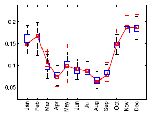Our research focuses on stochastic algorithms and software to model geological reservoirs.
 | DeeSse: the direct sampling code The Direct Sampling is a MPS methods that simulate complex patterns by resampling a training data set. The method is patented by the University of Neuchâtel and DeeSse is an efficient (and parallel) implementation of the method in C. This software evolves regularly and contains all the last results from our research in this domain. More information. |
 | Block conditionning MPS methods consist in borrowing patterns from a training set. In this project, we propose an extension of MPS able to deal with conditioning from block data, i.e. target mean values over subsets of the simulation domain. Our extension is based on the direct sampling algorithm and can be used for downscaling applications or inverse linear conditionning. More information. |
 | 3D models of caves from laser scanning A novel laser scanning device is developed in collaboration with the Austrian Geological Survey to measure the 3D geometry of sections of underwater caves. From these data, the aim is to model the full 3D geometry of the cave wall. This is done by modifying the odsim algorithm. More information. |
 | Inverse modeling in Karst Karstic networks are often not accessible but highly connected. The question that is raised in this work is whether inverse conditionning is able to identify the geometry of a conduit network from discharge time series in springs and tracer tests. More information. |
 | Modeling of braided systems Braided systems often constitute aquifers that are tape for water production. To model their heterogeneity, a methodology based on MPS simulation of successive topographies has been developped. It useds Lidar images of real braided systems as training. More information. |
 | Simulation of time series The direct sampling algorithm can also be used to simulate time series or to reconstruct missing data. In this work, we investigate such applications for daily rainfall and show the benefits for a potential user as compared to more sophisticated techniques More information. |
 | 3D simulation from 2D TI A frequent difficulty with MPS in geology is to get a 3D training data set. Here, we propose several methods to generate 3D simulations from 2D training images. The method has been tested in a case study in Denmark. More information. |